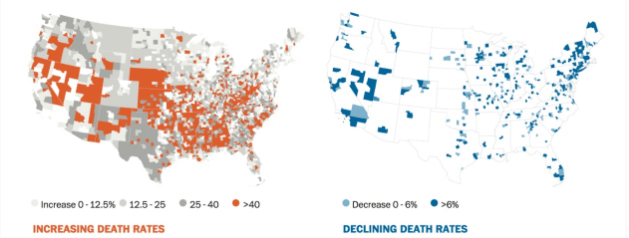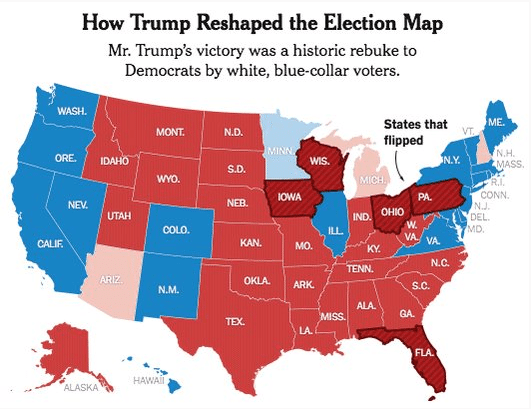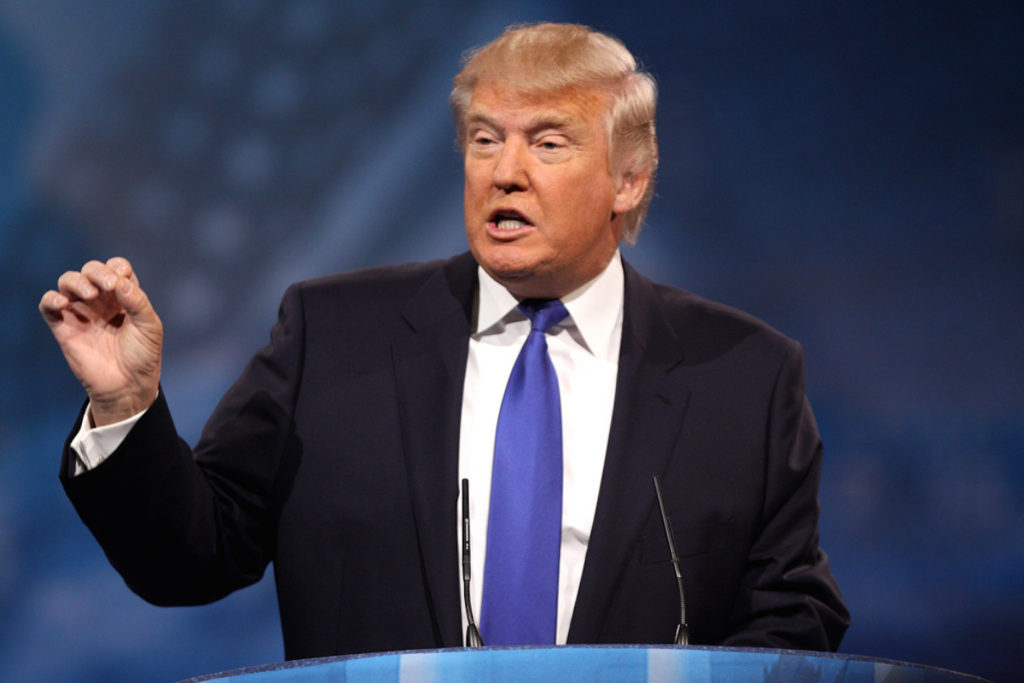What Is President-Elect Trump’s Plan To Fight Addiction?
Electoral Map Shows Most Successful Polling in Places Where More Americans Dying from Opioid Addiction
WASHINGTON, D.C. (November 10, 2016) – There is a strong connection between where President-elect showed the most success in voter turnout and where the most people are dying in the United States from opioid addiction. If you laid one map on top of the other, they are close to identical. As Inverse reported, the mortality rate for white people between 45-50 years old without a college education increased by 134 deaths per 100,000 in the past decade. Rural white women in their late 40s are experiencing the highest spike in deaths. Many in rural America have expressed distrust for the government and even gone as far as to suggest “white genocide” in the country. Here’s an analysis of changes in death rates of white women from the Washington Post:  Now here’s the 2016 Presidential election votes from the New York Times:
Now here’s the 2016 Presidential election votes from the New York Times: Obviously, data cannot support that the millions actually suffering from opioid addiction and who have lost loved ones to it were responsible for Trump’s victory, but many at least live in the same area. The gap between actual and expected mortality in recent years exceeded nearly 200 deaths per 100,000 people in states like West Virginia, Tennessee, Kentucky and Mississippi. Clinton proposed a $10 billion initiative to combat the problem, while Trump argued that we should focus on building a wall on the Mexican border to combat the flow of heroin into our country. “Heroin overdoses are taking over our children and others in the Midwest,” President-elect Trump Tweeted in August. “Coming in from our southern border. We need strong border & WALL!” The prospect of a wall received criticism from many in the medical community. “Building a wall is not a comprehensive plan to address our nation’s opioid crisis,” said Senator Ed Markey (D-Mass.). “Instead of building a wall, we need to tear down the wall of stigma and partisanship that has blocked real funding for responding to this opioid crisis.” “I think the FDA has additional authorities under federal law that they have failed to exercise, that could improve the risk-benefit balance of prescription opioids for millions of Americans,” said Bloomberg School of Public Health’s Dr. Caleb Alexander. Toward the end of his campaign, while visiting New Hampshire, President-elect Trump praised Congress for passing the Comprehensive Addiction Recovery Act as an important step in fighting addiction and has promised to increase first responders’ access to Naloxone. He encouraged in-patient treatment and swiftly deporting illegal immigrant working as drug traffickers. “It is tragedy enough that so many Americans are struggling with life-threatening addiction,” President-elect Trump said. “We should not compound that tragedy with government policies and bureaucratic rules that make it even harder for them to get help.” President-elect Trump pledged to combat the use of the highly powerful drug fentanyl and its importation from China and other countries and called for the FDA to approve painkillers with a less risk for addiction. He called on the Drug Enforcement Administration to restrict the number of opioids that can be manufactured in this country. He called for a larger increase in the number of patients doctors can treat at one time with taper drugs. All of these similar to Clinton’s plan released earlier this year. Perhaps the one issue they both agreed on in a long fought, dramatic campaign. “How does heroin work with these beautiful lakes and trees?” said Trump in New Hampshire. “It doesn’t.” While Trump has expressed his intentions, there has not yet been any proposal on specific spending, much like the proposed wall. According to the DEA, 79% of heroin it seized in 2014 came from Mexico. Trump also proposes to make it harder for China to ship drugs into the United States. The DEA says the country’s labs are producing fentanyl in mass amounts and marketing it to dealers in the U.S. Trump has also promised to combat the harboring of illegal immigrants that may be dealing drugs. While he hasn’t laid out the cost or how it will happen, Trump also proposes more incentives for drug courts in our communities. Clinton and Trump’s plans differed the most in the area of criminal justice. Trump hasn’t been specific on non-violent offenders, but praised Vice President-elect Mike Pence for instituting mandatory minimum sentences for drug offenses, and suggested that he would pursue more jail time on a federal level. Back in 1990, Trump called the U.S. drug enforcement policy “a joke”, and called for the legalization of drugs publicly to take the money away from the drug czars. Recently, he has stated that he is against recreational legalization of marijuana, but that medical marijuana was “a different story”. He has openly talked about his brother’s addiction to alcohol that ended in death. “My brother Fred was a great guy. He had everything,” said Trump. “I mean, the most handsome guy, and then he got hooked and there was nothing, there was nothing we could do about it.” His sympathy with those battling addictions was echoed when Trump gave a second chance to Miss USA Tara Conner who was caught using drugs. “Tara is willing to learn from her mistake and not let it happen again,” said Trump in 2008. “I decided it was better to give her a second chance than to destroy her career and ruin her chances in life.” We believe in second chances, too. Vertava Health is hopeful the next administration will continue in a passion for combating our nation’s deadly epidemic.
Obviously, data cannot support that the millions actually suffering from opioid addiction and who have lost loved ones to it were responsible for Trump’s victory, but many at least live in the same area. The gap between actual and expected mortality in recent years exceeded nearly 200 deaths per 100,000 people in states like West Virginia, Tennessee, Kentucky and Mississippi. Clinton proposed a $10 billion initiative to combat the problem, while Trump argued that we should focus on building a wall on the Mexican border to combat the flow of heroin into our country. “Heroin overdoses are taking over our children and others in the Midwest,” President-elect Trump Tweeted in August. “Coming in from our southern border. We need strong border & WALL!” The prospect of a wall received criticism from many in the medical community. “Building a wall is not a comprehensive plan to address our nation’s opioid crisis,” said Senator Ed Markey (D-Mass.). “Instead of building a wall, we need to tear down the wall of stigma and partisanship that has blocked real funding for responding to this opioid crisis.” “I think the FDA has additional authorities under federal law that they have failed to exercise, that could improve the risk-benefit balance of prescription opioids for millions of Americans,” said Bloomberg School of Public Health’s Dr. Caleb Alexander. Toward the end of his campaign, while visiting New Hampshire, President-elect Trump praised Congress for passing the Comprehensive Addiction Recovery Act as an important step in fighting addiction and has promised to increase first responders’ access to Naloxone. He encouraged in-patient treatment and swiftly deporting illegal immigrant working as drug traffickers. “It is tragedy enough that so many Americans are struggling with life-threatening addiction,” President-elect Trump said. “We should not compound that tragedy with government policies and bureaucratic rules that make it even harder for them to get help.” President-elect Trump pledged to combat the use of the highly powerful drug fentanyl and its importation from China and other countries and called for the FDA to approve painkillers with a less risk for addiction. He called on the Drug Enforcement Administration to restrict the number of opioids that can be manufactured in this country. He called for a larger increase in the number of patients doctors can treat at one time with taper drugs. All of these similar to Clinton’s plan released earlier this year. Perhaps the one issue they both agreed on in a long fought, dramatic campaign. “How does heroin work with these beautiful lakes and trees?” said Trump in New Hampshire. “It doesn’t.” While Trump has expressed his intentions, there has not yet been any proposal on specific spending, much like the proposed wall. According to the DEA, 79% of heroin it seized in 2014 came from Mexico. Trump also proposes to make it harder for China to ship drugs into the United States. The DEA says the country’s labs are producing fentanyl in mass amounts and marketing it to dealers in the U.S. Trump has also promised to combat the harboring of illegal immigrants that may be dealing drugs. While he hasn’t laid out the cost or how it will happen, Trump also proposes more incentives for drug courts in our communities. Clinton and Trump’s plans differed the most in the area of criminal justice. Trump hasn’t been specific on non-violent offenders, but praised Vice President-elect Mike Pence for instituting mandatory minimum sentences for drug offenses, and suggested that he would pursue more jail time on a federal level. Back in 1990, Trump called the U.S. drug enforcement policy “a joke”, and called for the legalization of drugs publicly to take the money away from the drug czars. Recently, he has stated that he is against recreational legalization of marijuana, but that medical marijuana was “a different story”. He has openly talked about his brother’s addiction to alcohol that ended in death. “My brother Fred was a great guy. He had everything,” said Trump. “I mean, the most handsome guy, and then he got hooked and there was nothing, there was nothing we could do about it.” His sympathy with those battling addictions was echoed when Trump gave a second chance to Miss USA Tara Conner who was caught using drugs. “Tara is willing to learn from her mistake and not let it happen again,” said Trump in 2008. “I decided it was better to give her a second chance than to destroy her career and ruin her chances in life.” We believe in second chances, too. Vertava Health is hopeful the next administration will continue in a passion for combating our nation’s deadly epidemic.


